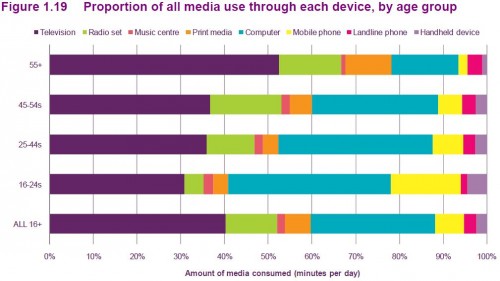The UK's media consumption habits
Ofcom released its seventh annual communications market report last week. Its a goldmine of information about media consumption habits in the UK and is worth reading in full, the internet section in particular. In terms of social media usage, it reveals interesting data such as:
- Social networking (in blue) is an all day long activity, filling the gaps between traditional media:
- The data above illustrates the popularity of television in the evening, when over half (52%) of all media activities undertaken involves watching television on a TV set. In the morning, radio is more popular, but declines by the evening when TV is at its peak. Text communications (including social media usage) and voice communications both make up a fair proportion of media activity during the daytime and after the end of television peak time
- Computer, mobile phone and hand-held devices all have higher levels of use among younger age groups. Almost three-fifths (58%) of all 16-24 year old media engagement is through one of these devices, compared to 18% for people aged over 55. By contrast, use of the more established devices and media, such as TV sets, radio sets, and print, generally increases with age:
- Two-fifths of people’s time on a computer is spent communicating with other people: for all age groups, communication makes up a large proportion of activity done on a computer. For 16-24s, it peaks to over half their computer time. They are more likely to use social networking (23% of all computer activity) and instant messaging (14%)
- Almost all homes with computers are now connected to the internet. Most internet connections are now broadband, with many consumers enjoying a rich variety of content online:
- Nevertheless, home internet access varies significantly by age and socio-economic group: among 15-54 year olds internet take-up is above 80%, and peaks at 85% among 35-54 year olds, but falls for consumers aged 55 and older. Despite this, much of the growth in internet take-up appears to have taken place among older age groups. There is also a relationship between levels of home internet take-up and socio-economic group: nearly nine in ten ABs report having a broadband connection; this drops steadily to 80% of C1s, 71% of C2s and 54% of DEs:
- Over 60% of 15-34 year olds access social networking sites at home:
- What’s more, all demographics have seen an annual rise of at least ten percentage points in the number of people claiming to have social networking profiles
- Social networking now accounts for nearly a quarter (23%) of all time spent online. This has been driven by the growth of Facebook, whose reach rose by 31%, reaching a unique monthly audience of nearly 25 million in the year to May 2010:
- Facebook users also spend substantially more time on the site than users of other social networking sites. The average Facebook user spent 6 hours 30 minutes on the site in April 2010, an average of 13 minutes a day. Thus, while Google is the leading brand in terms of reach, Facebook leads in terms of average time spent per person. For most other sites the figure was around half an hour or less
- Social networking sites have also taken advantage of the growing popularity of the mobile internet and the increasing take-up of smartphones. Using mobile devices to access social networking sites is particularly popular among younger adults:
- Indeed, for 16-24s text messaging and social networking together make up 64% of all mobile phone use
- User-generated content sites are continuing to grow: YouTube remains the most popular video-sharing site, growing by 13% year-on-year to reach 17.5 million monthly unique users. What’s more, commenting on blogs saw a significant growth in take-up between 2007 and 2009, from 19% to 27%: not all users are willing to share content but there is a growing interest in interacting with the content providers
- We also notice a strong difference of habits depending on the age of users: the younger an internet user is, the more likely they are to have experience of a given social media activity. For example, while a quarter (26%) of 16-24 year olds claimed to have made a short video and uploaded it to a website, only 2% of people aged 55+ with internet access make the same claim. The exception to this rule appears to be contributing to collaborative websites such as Wikipedia; 25-34 year olds were as likely to have done this as 16-24 year-olds:
- Communications activities such as emailing, texting and social networking all command high attention and high importance scores from consumers, whereas traditional forms of media consumption, such as watching scheduled television on a TV set, listening to live radio on a radio set, and reading print media attract high importance scores from people, along with lower average attention scores
Click to view the entire report, or just the internet section.








